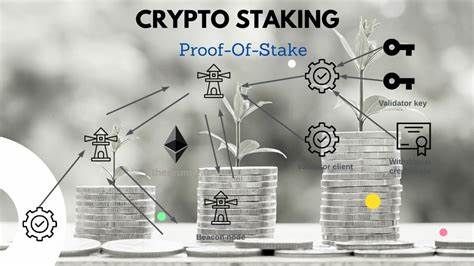Cryptocurrency has gained a lot of attention in recent years as a new and innovative way to invest and earn money. One of the latest trends in the crypto world is staking, a process that allows cryptocurrency investors to earn passive income by holding their coins in a staking wallet. In this article, we will explain what staking is, how it works, and how you can get started.
What is Crypto Staking?
Crypto staking is the process of holding cryptocurrency in a staking wallet and participating in the validation of transactions on a blockchain network. By holding and validating transactions, you can earn rewards in the form of more cryptocurrency. Staking is often used as an alternative to mining, which requires expensive hardware and consumes a lot of electricity.
How Does Crypto Staking Work?
When you stake your cryptocurrency, you are essentially helping to maintain the network and validate transactions. In order to participate in staking, you need to hold a certain amount of cryptocurrency in a staking wallet. The exact amount varies depending on the cryptocurrency and the network, but it is usually a minimum of a few hundred coins.
Once you have staked your coins, they are locked in the wallet for a certain period of time. During this time, you will be able to validate transactions and earn rewards. The length of time that your coins are locked up is called the staking period, and it can vary from a few days to several months.
The rewards that you earn from staking depend on the network that you are participating in. Some networks offer a fixed reward rate, while others use a more complex algorithm that takes into account the number of stakers and the amount of cryptocurrency that is being staked. In general, the more cryptocurrency you stake, the higher your rewards will be.
Benefits of Crypto Staking
There are several benefits to staking cryptocurrency, including:
- Passive income
Staking allows you to earn rewards without actively trading or investing in the market. This makes it an attractive option for people who want to earn passive income from their cryptocurrency holdings.
- Lower risk
Staking is generally considered to be lower risk than other forms of cryptocurrency investing, such as trading or mining. This is because you are not relying on market fluctuations or expensive hardware to earn rewards.
- Network participation
By staking your coins, you are helping to maintain and secure the network. This makes staking an important part of the cryptocurrency ecosystem and helps to support the long-term growth and success of the network.
How to Get Started with Crypto Staking?
If you are interested in staking cryptocurrency, here are the steps you need to follow:
- Choose a cryptocurrency: The first step is to choose a cryptocurrency that supports staking. Some popular options include Ethereum, Cardano, and Polkadot.
- Set up a staking wallet: Once you have chosen a cryptocurrency, you need to set up a staking wallet. This is a special type of wallet that is designed for staking and can be used to hold your staked coins.
- Buy and stake your cryptocurrency: Once you have set up your staking wallet, you can buy the cryptocurrency that you want to stake and transfer it to your staking wallet. You will then need to stake your coins, which typically involves following a few simple steps within the staking wallet.
- Earn rewards: Once you have staked your coins, you can sit back and earn rewards. The exact amount of rewards that you earn will depend on the network that you are participating in and the amount of cryptocurrency that you have staked.
10 Risks of Crypto Staking
Crypto staking is an increasingly popular way for cryptocurrency investors to earn passive income. While staking can offer several benefits, there are also a number of risks that investors should be aware of before getting involved. In this article, we will explore the 10 risks of crypto staking that every investor should consider.
- Network Risk
The first risk of crypto staking is network risk. This refers to the possibility that the block chain network you are staking on may experience technical issues or maybe hacked, resulting in a loss of funds. It is important to research the network you plan to stake on and ensure that it has a good track record of security and stability.
- Regulatory Risk
Regulatory risk refers to the possibility that governments may introduce laws or regulations that restrict or prohibit cryptocurrency staking. While this risk is relatively low, it is important to keep an eye on any regulatory developments that may impact your staking activities.
- Market Risk
Market risk is the possibility that the value of the cryptocurrency you are staking may decrease. This risk is inherent in all cryptocurrency investing and staking is no exception. It is important to monitor the market and stay informed about any developments that may impact the value of your staked coins.
- Liquidity Risk
Liquidity risk refers to the possibility that you may not be able to easily sell your staked coins or withdraw them from your staking wallet. This risk is particularly relevant for networks with long staking periods, as you may not be able to access your funds for several months.
- Inflation Risk
Inflation risk is the possibility that the rate of inflation on the network you are staking on may outpace the rewards you earn from staking. This can result in a decrease in the value of your staked coins over time.
- Cybersecurity Risk
Cybersecurity risk refers to the possibility that your staking wallet may be hacked or compromised, resulting in a loss of funds. It is important to choose a staking wallet that has strong security features and to keep your private keys safe.
- Counterparty Risk
Counterparty risk is the possibility that the staking provider you are using may go bankrupt or become insolvent, resulting in a loss of funds. It is important to choose a reputable staking provider with a good track record of security and reliability.
- Operational Risk
Operational risk refers to the possibility of errors or problems arising from the operation of the staking network or the staking provider. This can include technical issues, human error, or other unforeseen events.
- Centralization Risk
Centralization risk refers to the possibility that a small group of stakers may control a large portion of the staked coins on a network, leading to a concentration of power and potential manipulation of the network.
- Exit Risk
Finally, exit risk refers to the possibility that you may not be able to easily exit your staking position or withdraw your staked coins due to technical issues, network congestion, or other factors. This risk is particularly relevant for networks with high demand for staking.
Conclusion
In conclusion, while crypto staking can be a lucrative way to earn passive income, it is important to be aware of the risks involved. Investors should carefully consider each of these risks and take steps to mitigate them before getting involved in crypto staking.
This includes choosing a reputable staking provider, diversifying your staking portfolio, and staying informed about developments in the cryptocurrency market. By doing so, you can minimize your risk and maximize your potential returns from crypto staking.



































